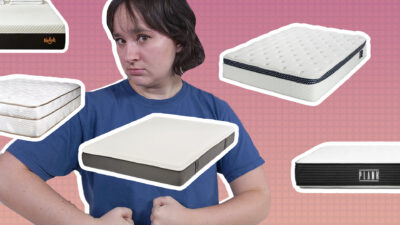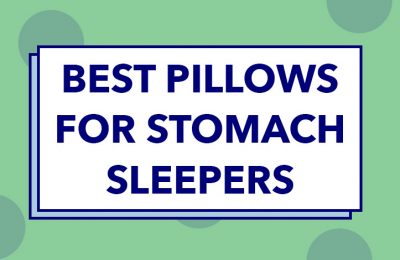Some of us may sleep on our stomachs periodically, but stomach sleepers who do so for the majority of the night are a rare breed. Of all the sleeping positions, stomach sleeping is the least common, with some research suggesting only 16 percent of us stomach sleep on a routine basis. Physical therapist and Sleepopolis Expert Network member Dr. Keith Poorbaugh tells us that the position can also be tricky when it comes to your health. That’s why it’s so important for these folks to match themselves with the right bed. Keep reading so you can make an informed decision and find the best mattress for stomach sleepers.
While selecting these mattresses, we performed tests on every single one to determine its quality of execution in areas such as support, cooling, pain relief, and more. For stomach sleepers, we paid special attention to support, since these folks need the firmest and most supportive beds that encourage a healthy spinal alignment. Something that’s too soft or ends up losing its shape in the middle of the night can throw the spine out of alignment.
Our Top Pick For Stomach Sleepers
The Helix Dawn is our top pick for stomach sleepers because of its ability to provide both support and comfort. It keeps the hips from sinking too far into the mattress (which can cause back pain), yet is still soft and cozy.
Best Mattresses for Stomach Sleepers of 2024
- Helix Dawn – Best Overall Mattress for Stomach Sleepers
- Nectar Hybrid – Best Stomach-Sleeping Mattress for Kids
- Winkbeds Original – Best Hybrid Mattress for Stomach Sleepers
- Saatva – Best Mattress for Stomach Sleepers with Back Pain
- Plank Firm – Best Firm Mattress for Stomach Sleepers
- Emma Hybrid Comfort – Best Mattress for Couples
- Bear Elite Hybrid – Best Soft Mattress for Stomach Sleepers
- Nolah Evolution – Best Cooling Mattress for Stomach Sleepers
- Brooklyn Bedding Signature Hybrid – Best Mattress for Lightweight Stomach Sleepers
Best Mattress for Stomach Sleepers Video
Compare the Best Mattresses for Stomach Sleepers
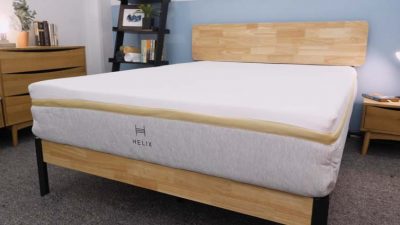

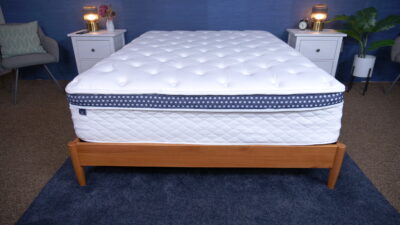
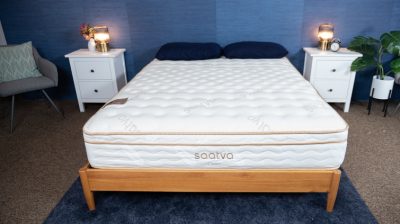
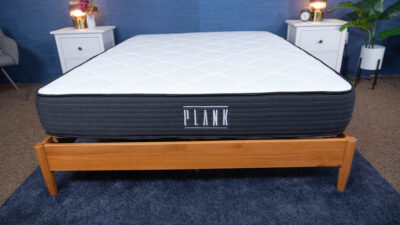
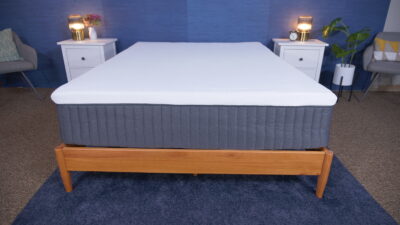
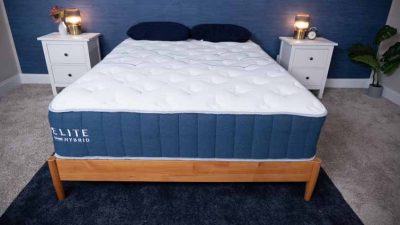
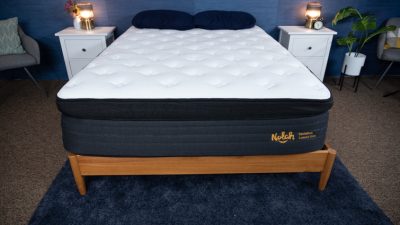
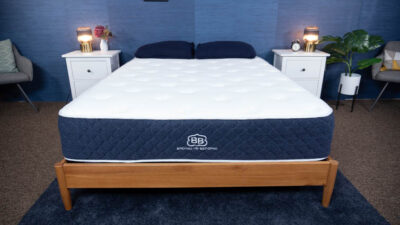
Helix Dawn Mattress
Nectar Hybrid Mattress
WinkBed Mattress
Saatva Mattress
Brooklyn Bedding Plank Firm Mattress
Emma Hybrid Comfort
Bear Elite Hybrid Mattress
Nolah Evolution Hybrid Mattress
Brooklyn Bedding Signature Hybrid Mattress
Rating
Firmness
Firm: 7.5/10
Medium-firm: 6.5/10
Multiple firmness options
Multiple firmness options
Multiple firmness options
Firm: 7.5/10
Multiple firmness options
Multiple firmness options
Multiple firmness options
Material
Hybrid
Hybrid
Hybrid
Innerspring
Foam
Hybrid
Hybrid
Hybrid
Hybrid
Cooling
--
--
✓
✓
--
✓
✓
--
--
Sleep Position
Back & Stomach
Back
Combination
Back & Stomach
Back & Stomach
Back & Stomach
Back & Stomach
Back & Side
Back
Helix Dawn – Best Overall Mattress for Stomach Sleepers
The Helix Dawn is the firmest model Helix Sleep offers. It uses strong support to provide a great feel for back and stomach sleepers. The hybrid build provides good bounce and mobility so you’ll be able to change positions easily too.
We recommend this mattress for the following sleeper types: Financing options are available for this mattress. The Helix Dawn is the firmest model Helix Sleep offers. It uses strong support to provide a great feel for back and stomach sleepers. The hybrid build provides good bounce and mobility so you’ll be able to change positions easily too.
We recommend this mattress for the following sleeper types: Financing options are available for this mattress. The Helix Dawn is the firmest model Helix Sleep offers. It uses strong support to provide a great feel for back and stomach sleepers. The hybrid build provides good bounce and mobility so you’ll be able to change positions easily too.
We recommend this mattress for the following sleeper types: Financing options are available for this mattress.Helix Dawn Mattress

Material
Hybrid
Trial Period
100 nights
Shipping Method
Free shipping
Firmness
Firm: 7.5/10
Warranty
10-year warranty
Price Range
$$$$$
Couples
This bed has great motion isolation so you will not feel your partner tossing and turning at night.
Back Sleeping
Ideal for average weight back sleepers.
Stomach Sleeping
Ideal for lightweight and average weight stomach sleepers.
Financing Options
Helix Dawn Mattress

Material
Hybrid
Warranty
10-year warranty
Firmness
Firm: 7.5/10
Shipping Method
Free shipping
Trial Period
100 nights
Price Range
$$$$$
Couples
This bed has great motion isolation so you will not feel your partner tossing and turning at night.
Back Sleeping
Ideal for average weight back sleepers.
Stomach Sleeping
Ideal for lightweight and average weight stomach sleepers.
Financing Options

Helix Dawn Mattress
Material
Hybrid
Firmness
Firm: 7.5/10
Trial Period
100 nights
Warranty
10-year warranty
Shipping Method
Free shipping
Price Range
$$$$$
Couples
This bed has great motion isolation so you will not feel your partner tossing and turning at night.
Back Sleeping
Ideal for average weight back sleepers.
Stomach Sleeping
Ideal for lightweight and average weight stomach sleepers.
Financing Options
Expert Opinion
While there are a ton of hybrids available online, we like the Helix Dawn for stomach sleepers because of its balanced feel and high level of support. When we laid on the mattress to test it out, its top layer of foam provided soothing pressure relief at the shoulders and hips without causing the spine to dip out of alignment with the rest of the torso. At the same time, a sturdy layer of springs at the bottom of the mattress gave us an additional lift, further contributing to a healthy spinal alignment. All of this results in an even line from head to toe, which is key to avoiding back pain while stomach sleeping.
What our tester says: “I really appreciate how supportive the Helix Dawn is. Stomach sleepers, back sleepers, and heavy people could all benefit from the firm feel of this bed. It really delivers on lumbar support.” – Logan Block, former Sleepopolis director of content and mattress tester
What Customers Say
Shoppers have positive things to say about the Helix Sleep Quiz, which is a 30-second quiz to determine which Helix model is best for shoppers’ individual needs. Customers say that even if their mattress ended up not being the best fit, it was easy to exchange their mattress for a better Helix option.
Pros of the Helix Dawn Mattress
- Budget shoppers should appreciate that the Helix Dawn comes at an affordable price point.
- This mattress sleeps cool with its light fabric cover and pocketed coils, making it a solid option for hot sleepers.
- The excellent motion isolation and edge support works well for two.
Cons the Helix Dawn Mattress
- If you’re someone who wants a mattress with a lot of pressure relief or sinkage, then the highly firm Helix Dawn may not for you.
Like what you see in the Helix Dawn? Get our best deal here. For more, take a look at our full Helix Dawn mattress review. You can also look at other choices on our best mattresses page.
Nectar Hybrid – Best Stomach-Sleeping Mattress for Kids
The Nectar Classic Hybrid has the same popular layers of foam found in other Nectar beds that offer pressure relief and comfort, but the coils inside the hybrid also bring sleepers extra support and airflow.
The Nectar Classic Hybrid has the same popular layers of foam found in other Nectar beds that offer pressure relief and comfort, but the coils inside the hybrid also bring sleepers extra support and airflow.
The Nectar Classic Hybrid has the same popular layers of foam found in other Nectar beds that offer pressure relief and comfort, but the coils inside the hybrid also bring sleepers extra support and airflow.
Nectar Hybrid Mattress

Material
Hybrid
Trial Period
365 nights
Shipping Method
Free shipping minus HI and AK
Firmness
Medium-firm: 6.5/10
Warranty
Lifetime warranty
Price Range
$$$$$
Nectar Hybrid Mattress

Material
Hybrid
Warranty
Lifetime warranty
Firmness
Medium-firm: 6.5/10
Shipping Method
Free shipping minus HI and AK
Trial Period
365 nights
Price Range
$$$$$

Nectar Hybrid Mattress
Material
Hybrid
Firmness
Medium-firm: 6.5/10
Trial Period
365 nights
Warranty
Lifetime warranty
Shipping Method
Free shipping minus HI and AK
Price Range
$$$$$
Expert Opinion
During our series of tests, the Nectar Hybrid displayed an excellent one-two punch of pressure relief and support. This is spectacular news for stomach-sleeping kids around or under 130 pounds. We think these kiddos should get enough lift at the hips while dozing on their stomachs, ensuring proper spinal alignment throughout the night.
The support comes from a thick layer of individually-wrapped coils and a dynamic response layer, which elevates sleepers’ hips. To make sure there’s not too much pressure, there’s a quilted cover and a cushioning layer of memory foam for comfort.
What our tester says: “I really like how I felt comfortable sleeping on my back and side on this mattress. The top foams have a slower-moving feel, which is great for pressure relief and the coils bring added support and durability to the bed.” – Bridget Chapman, former senior product editor
What Customers Say
A lot of customers report that even though they usually sleep hot, the Nectar Hybrid feels cool to them and helps them get a more comfortable sleeping experience.
Pros of the Nectar Hybrid Mattress
- Its cooling cover, gel-infused memory foam, and breathable coils should keep kids nice and cool.
- The medium firmness of this mattress should appeal to most back-sleeping children as well.
- There’s a 365-night trial and lifetime warranty, so folks have plenty of time to decide if this mattress is best for their kid’s needs.
Cons of the Nectar Hybrid Mattress
- Side sleepers weighing less than 130 pounds may find the Nectar to be too firm.
Want to buy the Nectar Hybrid? Get our best deal here. To get more info, read our full Nectar Hybrid mattress review for all the details or visit our best mattresses for kids page.
WinkBeds Original – Best Hybrid Mattress for Stomach Sleepers
The WinkBed is a hybrid mattress that comes in three firmness levels, so most sleepers should find a model that suits their needs. It could also be a good fit for couples, thanks to reinforced edge support.
We recommend this mattress for the following sleeper types: Financing options are available for this mattress. Absolutely the greatest mattress I've ever slept on. It is soft yet firm in the right spots. Quality is on another level. You get what you pay for.
The WinkBed is a hybrid mattress that comes in three firmness levels, so most sleepers should find a model that suits their needs. It could also be a good fit for couples, thanks to reinforced edge support.
We recommend this mattress for the following sleeper types: Financing options are available for this mattress. Absolutely the greatest mattress I've ever slept on. It is soft yet firm in the right spots. Quality is on another level. You get what you pay for.
The WinkBed is a hybrid mattress that comes in three firmness levels, so most sleepers should find a model that suits their needs. It could also be a good fit for couples, thanks to reinforced edge support.
We recommend this mattress for the following sleeper types: Financing options are available for this mattress. Absolutely the greatest mattress I've ever slept on. It is soft yet firm in the right spots. Quality is on another level. You get what you pay for.
WinkBed Mattress

Material
Hybrid
Trial Period
120 nights
Shipping Method
Free shipping
Firmness
Multiple firmness options
Warranty
Lifetime warranty
Price Range
$$$$$
Hot Sleepers
If you often overheat while you sleep, this mattress should help you stay cool.
Back Pain
This bed is perfect for anyone suffering from back pain.
Back Sleeping
Ideal for lightweight and average weight back sleepers.
Side Sleeping
Ideal for lightweight and average weight side sleepers.
Stomach Sleeping
Ideal for average weight stomach sleepers.
Financing Options
WinkBed Mattress

Material
Hybrid
Warranty
Lifetime warranty
Firmness
Multiple firmness options
Shipping Method
Free shipping
Trial Period
120 nights
Price Range
$$$$$
Hot Sleepers
If you often overheat while you sleep, this mattress should help you stay cool.
Back Pain
This bed is perfect for anyone suffering from back pain.
Back Sleeping
Ideal for lightweight and average weight back sleepers.
Side Sleeping
Ideal for lightweight and average weight side sleepers.
Stomach Sleeping
Ideal for average weight stomach sleepers.
Financing Options

WinkBed Mattress
Material
Hybrid
Firmness
Multiple firmness options
Trial Period
120 nights
Warranty
Lifetime warranty
Shipping Method
Free shipping
Price Range
$$$$$
Hot Sleepers
If you often overheat while you sleep, this mattress should help you stay cool.
Back Pain
This bed is perfect for anyone suffering from back pain.
Back Sleeping
Ideal for lightweight and average weight back sleepers.
Side Sleeping
Ideal for lightweight and average weight side sleepers.
Stomach Sleeping
Ideal for average weight stomach sleepers.
Financing Options
Expert Opinion
The WinkBeds Original mattress comes in three different models (Softer, Luxury Firm, and Firmer) so that sleepers really can pick the best firmness level for their sleeping needs and preferences. As a hybrid mattress, the WinkBeds Original includes both helix coils and plush foams.
The coils included in the construction of this mattress have multiple support zones, which means that certain areas of your body will be more supported during the night, while other areas will be better able to feel the foams in the WinkBeds Original. Stomach sleepers should be able to get the lift and support they need from this mattresses’s coils, while their more sensitive areas should get extra pressure relief from the Tencel cover and Euro pillow top.
What our tester says: “One of my favorite things about the WinkBed is its durability. This is a high-quality mattress that should really stand the test of time. This is great news for any sleeper, but especially nice for heavy people and couples.” – Bridget Chapman, former senior product editor
What Customers Say
The customer reviews on the WinkBeds website often praise this mattress for its ability to alleviate their pain, especially around the lumbar region. Many users stated that their back pain completely went away after sleeping on the WinkBeds Original for only a couple of months.
Pros of the WinkBeds Original Mattress
- Back sleepers should appreciate the WinkBeds Original because of its quilted Tencel cover that helps to contour and fill the lumbar region, providing pressure relief for the lower back.
- The tall pocketed coil layer included in the WinkBeds Original helps to promote airflow, so hot sleepers should stay cool throughout the night.
- The WinkBeds Original is made with CertiPUR-US Certified foams, so it’s free from harmful chemicals and heavy metals.
Cons of the WinkBeds Original Mattress
- Strict side sleepers that are looking for a mattress with added sinkage for joint pain might want to opt for a softer bed than the WinkBeds Original.
Think the WinkBeds Original is the mattress of your dreams? Click here for our best deal. For more information, check out our full WinkBeds Original review or visit our best hybrid mattress page for more options.
Saatva – Best Mattress for Stomach Sleepers with Back Pain
The Saatva is firm enough to keep the hips and shoulders aligned, which is important for stomach sleepers. This healthy, neutral position will help in relieving discomfort associated with back pain. We recommend this mattress for the following sleeper types: Financing options are available for this mattress. We were skeptical of buying a mattress on line but it could not have gone any smoother. Anthony answered all of our questions during our many phone conversations. Delivery was prompt and went without a hitch. Best of all the mattress is so comfortable! I haven't had such a good night sleep in years. Highly recommend this.
The Saatva is firm enough to keep the hips and shoulders aligned, which is important for stomach sleepers. This healthy, neutral position will help in relieving discomfort associated with back pain. We recommend this mattress for the following sleeper types: Financing options are available for this mattress. We were skeptical of buying a mattress on line but it could not have gone any smoother. Anthony answered all of our questions during our many phone conversations. Delivery was prompt and went without a hitch. Best of all the mattress is so comfortable! I haven't had such a good night sleep in years. Highly recommend this.
The Saatva is firm enough to keep the hips and shoulders aligned, which is important for stomach sleepers. This healthy, neutral position will help in relieving discomfort associated with back pain. We recommend this mattress for the following sleeper types: Financing options are available for this mattress. We were skeptical of buying a mattress on line but it could not have gone any smoother. Anthony answered all of our questions during our many phone conversations. Delivery was prompt and went without a hitch. Best of all the mattress is so comfortable! I haven't had such a good night sleep in years. Highly recommend this.
Saatva Mattress

Material
Innerspring
Trial Period
365 nights
Shipping Method
Free white glove delivery
Firmness
Multiple firmness options
Warranty
Lifetime warranty
Price Range
$$$$$
Hot Sleepers
If you often overheat while you sleep, this mattress should help you stay cool.
Back Pain
This bed is perfect for anyone suffering from back pain.
Back Sleeping
Ideal for lightweight, average weight, and heavyweight back sleepers.
Stomach Sleeping
Ideal for lightweight and average weight stomach sleepers.
Financing Options
Saatva Mattress

Material
Innerspring
Warranty
Lifetime warranty
Firmness
Multiple firmness options
Shipping Method
Free white glove delivery
Trial Period
365 nights
Price Range
$$$$$
Hot Sleepers
If you often overheat while you sleep, this mattress should help you stay cool.
Back Pain
This bed is perfect for anyone suffering from back pain.
Back Sleeping
Ideal for lightweight, average weight, and heavyweight back sleepers.
Stomach Sleeping
Ideal for lightweight and average weight stomach sleepers.
Financing Options

Saatva Mattress
Material
Innerspring
Firmness
Multiple firmness options
Trial Period
365 nights
Warranty
Lifetime warranty
Shipping Method
Free white glove delivery
Price Range
$$$$$
Hot Sleepers
If you often overheat while you sleep, this mattress should help you stay cool.
Back Pain
This bed is perfect for anyone suffering from back pain.
Back Sleeping
Ideal for lightweight, average weight, and heavyweight back sleepers.
Stomach Sleeping
Ideal for lightweight and average weight stomach sleepers.
Financing Options
Expert Opinion
The Saatva Classic is considered a luxury innerspring mattress. During our tests, it proved to be durable and supportive, and it helps maintain proper spinal alignment for stomach sleepers. Those with back pain may appreciate how this mattress is not prone to sagging, and should maintain its shape for years to come. The Saatva’s bouncy coils also provide ease of movement for seniors and combination sleepers.
Combo sleepers are people who switch between several different sleeping positions at night, and the responsive springs make it easy for them to switch positions. One important note: the mattress is available in several different firmness levels. We recommend the Firm or Luxury Firm for stomach sleepers.
What our tester says: “The Saatva Classic is a bouncy, high-quality mattress with durability and great edge support. I think it’s a nice option for back sleepers and combination sleepers. I also like the Saatva for heavier sleepers.” – Bridget Chapman, former senior product editor
What Customers Say
Shoppers say that both in-store and online customer service experiences have been more than satisfactory, from the knowledge level to the response time of Saatva representatives.
Pros of the Saatva Mattress
- Back sleepers could be comfortable on the Firm Model of the Saatva, and side sleepers might find what they need on the Plush Soft model of the mattress.
- This mattress’s coil-on-coil construction that creates bounce and makes it easier to move about the mattress.
- This innerspring-style mattress is incredibly supportive and gives the Saatva excellent edge support and durability.
Cons of the Saatva Mattress
- The Saatva has high motion transfer, which is common for innerspring mattresses. This means it may not be the best for couples who awaken easily.
- As the Saatva has an innerspring feel, it does lack in pressure relief, so perhaps not the best option for shoulder or hip pain.
Interested? Get our best deal here. For more, check out our full Saatva mattress review or visit our best mattresses for back pain page to find the right mattress for you.
Plank Firm – Best Firm Mattress for Stomach Sleepers
The Plank Firm mattress is an all-foam, flippable mattress with a firm side and an extra-firm side, which makes it ideal for stomach sleepers. Both sides of the mattress should provide them with the right level support they need. We recommend this mattress for the following sleeper types: Financing options are available for this mattress. This is my 4th foam mattress. Lasting firmness is one of the challenges I have come across with the mattresses. This is the most firm I have purchased and after a few weeks, I am still happy.
The Plank Firm mattress is an all-foam, flippable mattress with a firm side and an extra-firm side, which makes it ideal for stomach sleepers. Both sides of the mattress should provide them with the right level support they need. We recommend this mattress for the following sleeper types: Financing options are available for this mattress. This is my 4th foam mattress. Lasting firmness is one of the challenges I have come across with the mattresses. This is the most firm I have purchased and after a few weeks, I am still happy.
The Plank Firm mattress is an all-foam, flippable mattress with a firm side and an extra-firm side, which makes it ideal for stomach sleepers. Both sides of the mattress should provide them with the right level support they need. We recommend this mattress for the following sleeper types: Financing options are available for this mattress. This is my 4th foam mattress. Lasting firmness is one of the challenges I have come across with the mattresses. This is the most firm I have purchased and after a few weeks, I am still happy.
Brooklyn Bedding Plank Firm Mattress

Material
Foam
Trial Period
120 nights
Shipping Method
Free shipping
Firmness
Multiple firmness options
Warranty
10-year warranty
Price Range
$$$$$
Back Pain
This bed is perfect for anyone suffering from back pain.
Stomach Sleeping
Ideal for average weight and heavyweight stomach sleepers.
Financing Options
Brooklyn Bedding Plank Firm Mattress

Material
Foam
Warranty
10-year warranty
Firmness
Multiple firmness options
Shipping Method
Free shipping
Trial Period
120 nights
Price Range
$$$$$
Back Pain
This bed is perfect for anyone suffering from back pain.
Stomach Sleeping
Ideal for average weight and heavyweight stomach sleepers.
Financing Options

Brooklyn Bedding Plank Firm Mattress
Material
Foam
Firmness
Multiple firmness options
Trial Period
120 nights
Warranty
10-year warranty
Shipping Method
Free shipping
Price Range
$$$$$
Back Pain
This bed is perfect for anyone suffering from back pain.
Stomach Sleeping
Ideal for average weight and heavyweight stomach sleepers.
Financing Options
Expert Opinion
The Plank Firm is one of the firmest mattresses on the market, meaning there’s little room for sinkage when you lie on your stomach. That’s what we look for when recommending a mattress to stomach sleepers since it helps align their spine and hips. But what’s most special about it is its flippable quality. One side is a 7.5 out of 10, while the other is 8 out of 10. This firmer feel is ideal for stomach sleepers, but also heavier stomach sleepers. The foams in this mattress are incredibly dense and durable, so they’ll provide plenty of support.
On both sides of the mattress, our hips stayed elevated while in the prone position, so either one could work well for stomach sleepers with back pain. Stomach sleepers with shoulder pain should be comfortable on the less firm side, but those with hip pain may not feel enough pressure relief, depending on their needs.
What our tester says: “I really like that the Plank Firm is a flippable mattress with two firmness options. This makes it feel like you’re getting two beds for the price of one. I also think this is a great choice for anyone who loves a firm feel.” – Bridget Chapman, former senior product editor
What Customers Say
Customers seem to appreciate that the Plank Firm stays firm all night long, as opposed to losing its shape halfway through and throwing the spine out of alignment.
Pros of the Plank Firm Mattress
- Uncertain shoppers can use the 120-night trial to choose whether the firm and extra-firm side is best for them, or if they’re better off with another Brooklyn Bedding model.
- Sleepers who rest on their backs and appreciate a firm mattress might also enjoy the Plank Firm.
- Folks who toss and turn in their sleep should find ease of movement on the Plank Firm.
Cons of the Plank Firm Mattress
- Being all-foam, the Plank Firm sleeps a bit hot, but you can add an optional cooling panel for an additional charge.
Is the Plank Firm your ideal mattress? Get our best deal here. Read more in our full Plank Firm mattress review or visit our best firm mattresses page to find the right mattress for you.
Emma Hybrid Comfort – Best Mattress for Couples
Emma Hybrid Comfort

The Emma Hybrid Comfort is a firm, supportive, and bouncy mattress. A good fit for back sleepers and stomach sleepers, it also has open-celled foam for cooling.
Material
Hybrid
Trial Period
365 nights
Shipping Method
Free shipping
Firmness
Firm: 7.5/10
Warranty
10-year warranty
Price Range
$$$$$
We recommend this mattress for the following sleeper types:
Hot Sleepers
If you often overheat while you sleep, this mattress should help you stay cool.Back Sleeping
Ideal for average weight and heavyweight back sleepers.Stomach Sleeping
Ideal for lightweight and heavyweight stomach sleepers.Financing Options
Financing options are available for this mattress.
Emma Hybrid Comfort

The Emma Hybrid Comfort is a firm, supportive, and bouncy mattress. A good fit for back sleepers and stomach sleepers, it also has open-celled foam for cooling.
Material
Hybrid
Warranty
10-year warranty
Firmness
Firm: 7.5/10
Shipping Method
Free shipping
Trial Period
365 nights
Price Range
$$$$$
We recommend this mattress for the following sleeper types:
Hot Sleepers
If you often overheat while you sleep, this mattress should help you stay cool.Back Sleeping
Ideal for average weight and heavyweight back sleepers.Stomach Sleeping
Ideal for lightweight and heavyweight stomach sleepers.Financing Options
Financing options are available for this mattress.

Emma Hybrid Comfort
The Emma Hybrid Comfort is a firm, supportive, and bouncy mattress. A good fit for back sleepers and stomach sleepers, it also has open-celled foam for cooling.
Material
Hybrid
Firmness
Firm: 7.5/10
Trial Period
365 nights
Warranty
10-year warranty
Shipping Method
Free shipping
Price Range
$$$$$
We recommend this mattress for the following sleeper types:
Hot Sleepers
If you often overheat while you sleep, this mattress should help you stay cool.Back Sleeping
Ideal for average weight and heavyweight back sleepers.Stomach Sleeping
Ideal for lightweight and heavyweight stomach sleepers.Financing Options
Financing options are available for this mattress.
Expert Opinion
Stomach sleepers should adore the Emma Hybrid Comfort. It’s built to be a durable and supportive mattress, and its 7.5 out of 10 firmness level should keep stomach sleepers’ hips lifted throughout the night. But finding a mattress that works for not one sleeper but two is quite the challenge. By our standards, the best mattresses for couples do well with motion isolation, edge support, cooling, and responsiveness. We were delighted to see that the Emma Hybrid Comfort is a mattress that excels in all four categories, scoring at least a 4 out of 5 or higher on its tests. We weren’t exactly surprised. This hybrid bed utilizes sturdy coils, high-quality foams, and lots of cooling technology to create a durable yet cushioning mattress.
When putting this mattress through our motion isolation test, we dropped a 10-pound steel ball from three different heights and measured the level of disturbance with a seismometer. We found that the Emma Hybrid Comfort showed little disturbance and we’re confident it should do really well at isolating motion. So, you’re unlikely to be disturbed by your partner at night.
What our tester says: “I think side sleepers will be most compatible with the plush feeling of the soft side, while back/stomach/combo sleepers will prefer the firmer one. The bed does a good job of motion isolation across the mattress, an important feature for couples.” – Bridget Chapman, former senior product editor
What Customers Say
Hot sleepers cheer on the Emma Hybrid Comfort’s ability to stay cool all night long. This can be a really important factor for those who overheat so much that they can’t fall or stay asleep.
Pros of the Emma Hybrid Comfort Mattress
- When rolling about on the mattress, we found it has a responsive, “on top of” feel that should appeal to combination sleepers and anyone looking for a wonderful mattress for sex.
- Our thermal gun cooling test revealed that the Hybrid Comfort has impressive cooling capabilities. This is thanks to the bed’s numerous cooling features: a moisture-wicking cover, cooling gel-infused foam, and breathable coils.
- This mattress is on the firmer side and should certainly appeal to most back sleepers as well.
Cons of the Emma Hybrid Comfort Mattress
- We wouldn’t recommend this bed to side sleepers, because the Emma Hybrid doesn’t provide quite enough pressure relief to cushion the shoulder and hip.
Interested in learning more about this bed? Get our best deal here. Or read our full Emma Hybrid Comfort mattress review and visit our best mattress for couples page for more options.
Bear Elite Hybrid – Best Soft Mattress for Stomach Sleepers
The Bear Elite Hybrid is Bear's “ultra-luxurious” model with a traditional mattress feel, plus advanced cooling and support technology. It comes in three different firmness levels: Soft, Medium, and Firm.
We recommend this mattress for the following sleeper types: Financing options are available for this mattress. Love it! I absolutely love this mattress and the adjustable frame. It’s helping my back issues so much. I highly recommend this mattress to anyone with back pain
The Bear Elite Hybrid is Bear's “ultra-luxurious” model with a traditional mattress feel, plus advanced cooling and support technology. It comes in three different firmness levels: Soft, Medium, and Firm.
We recommend this mattress for the following sleeper types: Financing options are available for this mattress. Love it! I absolutely love this mattress and the adjustable frame. It’s helping my back issues so much. I highly recommend this mattress to anyone with back pain
The Bear Elite Hybrid is Bear's “ultra-luxurious” model with a traditional mattress feel, plus advanced cooling and support technology. It comes in three different firmness levels: Soft, Medium, and Firm.
We recommend this mattress for the following sleeper types: Financing options are available for this mattress. Love it! I absolutely love this mattress and the adjustable frame. It’s helping my back issues so much. I highly recommend this mattress to anyone with back pain
Bear Elite Hybrid Mattress

Material
Hybrid
Trial Period
120 nights
Shipping Method
Free shipping
Firmness
Multiple firmness options
Warranty
Lifetime Warranty
Price Range
$$$$$
Hot Sleepers
If you often overheat while you sleep, this mattress should help you stay cool.
Back Sleeping
Ideal for lightweight, average weight, and heavyweight back sleepers.
Stomach Sleeping
Ideal for lightweight and average weight stomach sleepers.
Financing Options
Bear Elite Hybrid Mattress

Material
Hybrid
Warranty
Lifetime Warranty
Firmness
Multiple firmness options
Shipping Method
Free shipping
Trial Period
120 nights
Price Range
$$$$$
Hot Sleepers
If you often overheat while you sleep, this mattress should help you stay cool.
Back Sleeping
Ideal for lightweight, average weight, and heavyweight back sleepers.
Stomach Sleeping
Ideal for lightweight and average weight stomach sleepers.
Financing Options

Bear Elite Hybrid Mattress
Material
Hybrid
Firmness
Multiple firmness options
Trial Period
120 nights
Warranty
Lifetime Warranty
Shipping Method
Free shipping
Price Range
$$$$$
Hot Sleepers
If you often overheat while you sleep, this mattress should help you stay cool.
Back Sleeping
Ideal for lightweight, average weight, and heavyweight back sleepers.
Stomach Sleeping
Ideal for lightweight and average weight stomach sleepers.
Financing Options
Expert Opinion
Although we found the Bear Elite Hybrid mattress to have a soft design, it still has a more “on top of the bed” feel. It comes in three firmness levels, but stomach sleepers should do best on the Firm version. It’s key for stomach sleepers to have their hips elevated, so they’re in alignment with their spine. This helps prevent future back pain.
We found the Bear Elite Hybrid’s sturdy coils to keep our bodies lifted and in proper alignment. Still, the Bear Elite Hybrid provides adequate cushioning for stomach sleepers; it has two foam layers to relieve pressure without letting folks sink too far into the mattress materials. Those with back pain, shoulder pain, and hip pain should also find a sufficient amount of pressure relief on this mattress.
What our tester says: “Stomach sleepers need a firm bed to keep their hips elevated and in alignment with their spine. I would suggest they try out the Firm version. Shoppers with a certain price range in mind could also potentially find the Bear Elite to be above their ideal price point, but keep in mind that we have coupons to help you out. ” – Bridget Chapman, former senior product editor
What Customers Say
A lot of folks are saying that the Bear Elite Hybrid helps ease their back pain, leading to a more restful sleep.
Pros of the Bear Elite Hybrid Mattress
- The cover includes Celliant, which some research suggests may help muscle recovery by promoting blood flow. It’s no wonder why the Bear Elite Hybrid is one of the best mattresses for athletes.
- Because of its motion isolation, responsiveness, and strong edge support, it’s a fantastic option for couples.
- Copper-infused memory foam and breathable coils work to keep hot sleepers cool.
Cons of the Bear Elite Hybrid Mattress
- With a softer feel, the Bear Elite Hybrid may not be supportive enough for heavy stomach sleepers.
Think this is the mattress for you? Get our best deal here. For more, head over to our full Bear Elite Hybrid mattress review or visit our roundup for the best soft mattresses.
Nolah Evolution – Best Cooling Mattress for Stomach Sleepers
The Nolah Evolution provides good pressure relief and body contouring. It’s a great choice for side sleepers, and back sleepers who like a softer mattress will enjoy it too. The soft pillow top is a great touch for shoulder or hip pain as well.
We recommend this mattress for the following sleeper types: Financing options are available for this mattress. An amazing mattress! Constructed with luxuriously well made materials that are breathable and incredibly comfortable. After almost one year of sleeping on this mattress, my husband and I are still talking about how much we love it. We both are combo sleepers and feel it's the perfect balance between soft and firm. Plus, no more waking up with a sore back or tight neck. Would highly recommend!!
The Nolah Evolution provides good pressure relief and body contouring. It’s a great choice for side sleepers, and back sleepers who like a softer mattress will enjoy it too. The soft pillow top is a great touch for shoulder or hip pain as well.
We recommend this mattress for the following sleeper types: Financing options are available for this mattress. An amazing mattress! Constructed with luxuriously well made materials that are breathable and incredibly comfortable. After almost one year of sleeping on this mattress, my husband and I are still talking about how much we love it. We both are combo sleepers and feel it's the perfect balance between soft and firm. Plus, no more waking up with a sore back or tight neck. Would highly recommend!!
The Nolah Evolution provides good pressure relief and body contouring. It’s a great choice for side sleepers, and back sleepers who like a softer mattress will enjoy it too. The soft pillow top is a great touch for shoulder or hip pain as well.
We recommend this mattress for the following sleeper types: Financing options are available for this mattress. An amazing mattress! Constructed with luxuriously well made materials that are breathable and incredibly comfortable. After almost one year of sleeping on this mattress, my husband and I are still talking about how much we love it. We both are combo sleepers and feel it's the perfect balance between soft and firm. Plus, no more waking up with a sore back or tight neck. Would highly recommend!!
Nolah Evolution Hybrid Mattress

Material
Hybrid
Trial Period
120 nights
Shipping Method
Free shipping
Firmness
Multiple firmness options
Warranty
Lifetime warranty
Price Range
$$$$$
Back Sleeping
Ideal for lightweight and average weight back sleepers.
Side Sleeping
Ideal for lightweight and average weight side sleepers.
Financing Options
Nolah Evolution Hybrid Mattress

Material
Hybrid
Warranty
Lifetime warranty
Firmness
Multiple firmness options
Shipping Method
Free shipping
Trial Period
120 nights
Price Range
$$$$$
Back Sleeping
Ideal for lightweight and average weight back sleepers.
Side Sleeping
Ideal for lightweight and average weight side sleepers.
Financing Options

Nolah Evolution Hybrid Mattress
Material
Hybrid
Firmness
Multiple firmness options
Trial Period
120 nights
Warranty
Lifetime warranty
Shipping Method
Free shipping
Price Range
$$$$$
Back Sleeping
Ideal for lightweight and average weight back sleepers.
Side Sleeping
Ideal for lightweight and average weight side sleepers.
Financing Options
Expert Opinion
Stomach sleepers looking for a mattress that won’t overheat should find what they’re looking for in the Nolah Evolution. It comes in three firmness levels and depending on body type, the Luxury Firm and Firm models are best for stomach sleeping. One of its comfort layers is made up of a proprietary material designed specifically for cooling. A second comfort layer has two inches of ArcticTex fibers, which is also designed for cooling.
On top of the bed, there’s a soft and breathable organic cotton cover for temperature regulation. And at the bottom, there’s a layer of HDMax EcoSupport coils for airflow. These springs are also where stomach sleepers will get most of their support. While testing this mattress, we found it feels very similarly to traditional memory foam. But luckily, it doesn’t trap much heat, unlike a number of mattresses out there.
What our tester says: “I love how the Nolah Evolution comes in three different firmness models, so you can choose the best fit for you. One of my favorite features of the Luxury Firm model is the soft pillow top. It’s a great touch for anyone that suffers from shoulder or hip pain. ” – Bridget Chapman, former senior product editor
What Customers Say
A lot of shoppers with hip pain note that the comfort layer helps relieve a lot of that pain and pressure.
Pros of the Nolah Evolution Mattress
- This mattress has impressive edge support, so you should be able to spread out and still feel supported. This feature also makes it a wonderful option for couples.
- The Nolah Evolution has two comfort layers that should ease the pressure off side sleepers’ shoulders and hips.
- The medium firmness of the Luxury Firm model allows a balance of plushness and sturdiness that’s ideal for back sleeping.
Cons the Nolah Evolution Mattress
- The Nolah Evolution may not be supportive enough for stomach sleepers over 250 pounds.
Want to check out the Nolah Evolution? Get our best deal here. For more, read our full Nolah Evolution mattress review. You can also visit our best cooling mattresses page for more options.
Brooklyn Bedding Signature Hybrid – Best Mattress for Lightweight Stomach Sleepers
The Brooklyn Bedding Signature is a hybrid mattress made out of a combination of memory foam and latex foam. The Signature offers a good amount of bounce that combination sleepers who move around in the middle of the night can enjoy.
We recommend this mattress for the following sleeper types: Financing options are available for this mattress. I bought this for my 92 year old father in law, after he tried mine that I purchased 7 years ago. He raves about it every day, he says he falls asleep faster, sleeps longer without waking up. He says it's so comfortable. He called me yesterday saying he can't thank me enough for setting him up with the mattress. He's really happy with it . Thank you!!
The Brooklyn Bedding Signature is a hybrid mattress made out of a combination of memory foam and latex foam. The Signature offers a good amount of bounce that combination sleepers who move around in the middle of the night can enjoy.
We recommend this mattress for the following sleeper types: Financing options are available for this mattress. I bought this for my 92 year old father in law, after he tried mine that I purchased 7 years ago. He raves about it every day, he says he falls asleep faster, sleeps longer without waking up. He says it's so comfortable. He called me yesterday saying he can't thank me enough for setting him up with the mattress. He's really happy with it . Thank you!!
The Brooklyn Bedding Signature is a hybrid mattress made out of a combination of memory foam and latex foam. The Signature offers a good amount of bounce that combination sleepers who move around in the middle of the night can enjoy.
We recommend this mattress for the following sleeper types: Financing options are available for this mattress. I bought this for my 92 year old father in law, after he tried mine that I purchased 7 years ago. He raves about it every day, he says he falls asleep faster, sleeps longer without waking up. He says it's so comfortable. He called me yesterday saying he can't thank me enough for setting him up with the mattress. He's really happy with it . Thank you!!
Brooklyn Bedding Signature Hybrid Mattress

Material
Hybrid
Trial Period
120 nights
Shipping Method
Free shipping
Firmness
Multiple firmness options
Warranty
10-year warranty
Price Range
$$$$$
Couples
This bed has great motion isolation so you will not feel your partner tossing and turning at night.
Back Sleeping
Ideal for average weight back sleepers.
Financing Options
Brooklyn Bedding Signature Hybrid Mattress

Material
Hybrid
Warranty
10-year warranty
Firmness
Multiple firmness options
Shipping Method
Free shipping
Trial Period
120 nights
Price Range
$$$$$
Couples
This bed has great motion isolation so you will not feel your partner tossing and turning at night.
Back Sleeping
Ideal for average weight back sleepers.
Financing Options

Brooklyn Bedding Signature Hybrid Mattress
Material
Hybrid
Firmness
Multiple firmness options
Trial Period
120 nights
Warranty
10-year warranty
Shipping Method
Free shipping
Price Range
$$$$$
Couples
This bed has great motion isolation so you will not feel your partner tossing and turning at night.
Back Sleeping
Ideal for average weight back sleepers.
Financing Options
Expert Opinion
The Brooklyn Bedding Signature is a hybrid mattress, meaning it uses a combination of foam (specifically memory foam or latex) and supportive coils. This hybrid construction offers a balance of pressure relief and support that is ideal for lightweight sleepers (those under 130 pounds).
The foams in the Brooklyn Bedding Signature Hybrid should allow these sleepers to sink into the mattress, especially around sensitive areas like the joints. At the same time, the coils should continue to keep their spine in a neutral alignment during the night, really providing these sleepers with the best of both worlds. Customers could also select the Firm model of this bed for the ultimate amount of support.
What our tester says: “I really like how the Brooklyn Bedding Signature Hybrid comes in three different firmness levels. It allows for all kinds of sleepers to find the right fit for them. I appreciate that the Brooklyn Signature Hybrid mattress isolates motion well, has strong edge support, and sleeps fairly cool.” – Bridget Chapman, former senior product editor
What Customers Say
Many customers praise the quick and easy delivery process that Brooklyn Bedding offers, which can be really important if you’re looking to get your mattress ASAP.
Pros of the Brooklyn Bedding Signature Hybrid Mattress
- The Brooklyn Bedding Signature promotes a healthy sleep posture for back sleepers, all while relieving pressure around the lower back.
- This mattress comes at a stellar value, since Brooklyn Bedding manufactures the mattresses in their own factory.
- The Signature’s solid edge support and good motion isolation makes it ideal for couples.
Cons of the Brooklyn Bedding Signature Hybrid Mattress
- Heavy stomach sleepers (those over 250 pounds) may want a firmer and more supportive mattress than the Signature can provide.
Thinking about trying this foam bed? Get our best deal here. Or you can check out our full Brooklyn Bedding Signature mattress review and visit our best mattress for lightweight sleepers page to find the right mattress for you.
Other Stomach Sleeper Mattresses We Love
- Cocoon mattress: The Cocoon (created by Sealy) is that rare all-foam mattress that still has enough firmness and support for stomach sleepers. That’s because it has an exceptionally thick base layer of poly foam that gives these folks the lift they need to keep their hips from bowing too far into the bed and throwing their spine out of alignment. It also sleeps very cool for a memory foam mattress. Read our full Cocoon mattress review.
- DreamCloud Premier mattress: An even more luxurious upgrade of the original DreamCloud, the DreamCloud Premier has soft memory foam up top, but firmer foam below that gradually transitions to a sturdy layer of coils. All of these materials should give most stomach sleepers the support they need (the exceptions are heavy sleepers and stomach sleepers struggling with back pain). As a bonus, it comes outfitted with a cozy cashmere cover. Read our full DreamCloud Premier mattress review.
- Purple mattress: The Purple mattress is known for its unique honeycombed grid. The little squares work together to give you support until a certain amount of pressure makes them collapse and provide relief. This dynamic feel is an especially stellar fit for lightweight stomach sleepers under 150 pounds, although average weight stomach sleepers and heavy sleepers will probably need something with a less flexible structure. Read our full Purple mattress review.
Pros and Cons of Stomach Sleeping
The right mattress can help mitigate some of the cons of stomach sleeping, but may not relieve them entirely. Proper firmness and support are key to sleeping with minimal tension on the neck and spine.
| Pros | Cons |
| Many find this position more comfortable and fall asleep more easily | Can contort and put pressure on the spine because of how the body’s weight is distributed |
| Lower risk of snoring/sleep apnea because of how the throat and tongue are positioned | Can cause neck, shoulder, and back strain (especially sleeping with both arms raised) |
| May decrease the likelihood of heartburn and gastroesophageal reflux disease | Muscle and joint strain can cause repeated awakenings during the night, leading to sleep deprivation |
Best Mattress Firmness to Suit Stomach Sleepers
Firmness vs Support
What does firmness mean when it comes to your mattress? Though firmness and support may sound similar, they have different definitions. Firmness refers to the initial feel when you first lie on a mattress. If the mattress immediately pushes back with a stiff sleeping surface, most people would consider it firm or very firm. Other mattresses have more of a cloud-like comfort with cushioning that immediately contours around the body. This would be considered plush or soft. A balanced level of push-back, hug, and contour would be considered a medium feel.
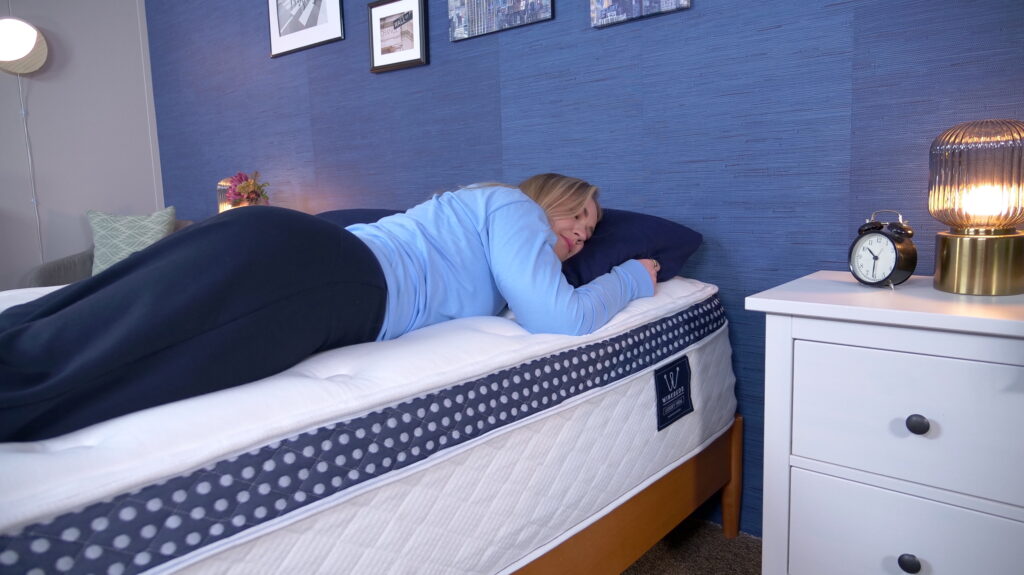
What Firmness Level Is Best for Stomach Sleepers?
Mattress firmness is described by a numerical 1-to-10 scale, with one being the softest and ten being the firmest. Most soft mattresses measure around 5 on the scale, while extra-firm mattresses measure around 8.
We generally recommend that stomach sleepers look for a mattress that comes in between 6.5 to 8 on the firmness scale, as some research suggests that softer mattresses may negatively impact your sleep quality in this position. This level will prevent the back from arching out of alignment and keep the hips lifted in line with the shoulders. Anything softer could cause discomfort in the pelvis and lower back.
Consider Body Weight
Body weight is also a factor when choosing a mattress. A stomach sleeper of average weight might consider a medium mattress (about a 6 on the scale) or a medium-firm mattress (around 6.5 to 7). Mattresses in this firmness range will be soft enough to conform to the body without sinking excessively. A mattress that measures above a 7 may help prevent heavier stomach sleepers from sinking too deeply and exacerbating joint and muscle strain.
Why Does Body Weight Matter?
There are several factors that can contribute to how a mattress preforms for you. Body weight is one of the components that can make a mattress feel like a dream to one sleeper but a nightmare to another.
For example, heavier sleepers may find that firmer mattresses with supportive layers work best for them and prevent them from sinking too far into the mattress, which can cause stiffness and pain in the morning. Overall, beds feel softer to heavier sleepers than to lightweight sleepers. Lightweight sleepers may find firm beds to feel uncomfortably firm because they’re unable to sink in and find pressure relief.
Firmness and Spinal Alignment for Stomach Sleepers
Though the firmness of your mattress is an important factor in how comfortably you sleep, Dr. Poorbaugh warns that it may not be enough to undo existing sleep posture issues. If you already suffer from back pain, you should avoid sleeping on your stomach.
“I advise clients to avoid stomach sleeping if they are experiencing any type of spinal pain,” he says. “The primary area of concern for stomach sleepers is spinal alignment. Even with proper pillow placement [discussed below], it’s difficult to maintain a neutral spine position in prone.”
If you’re a dedicated stomach sleeper and want to be as kind as possible to your muscles and joints, make sure you have the right mattress.
What About Mattress Support?
After firmness, support may be the most important concern for stomach sleepers. Support describes the uniformity of the mattress surface and the way it conforms to the body. Sound support will help to bolster the lower back, lift the hips, and reduce tension in the neck and shoulders.
To find a bed with solid support, consider the following:
- Firmness doesn’t always equal support, so pay attention to materials and construction. Hybrid beds utilize both foam and pocketed coils, and typically offer the most well-rounded support.
- When you try out a bed, make sure your hips and shoulders aren’t sinking out of alignment. Give your body a few minutes to settle before deciding if the support feels right.
- Focus less on the comfort layers and more on the support sections. Pillow-tops can be tantalizing, but stomach sleepers might need to feel what’s going on underneath.
Best Type of Mattress for Stomach Sleepers
A firmer, more supportive mattress may help reduce the discomfort and joint strain of stomach sleeping. But which type of mattress is best for you? Mattress options for people who sleep on their stomachs include the following:
- Latex is a responsive material with a slightly spongy feel. The responsiveness of latex can help reduce the “stuck” feeling that may occur with memory foam, so that switching positions is easier. Latex is known as a cooler material, making it a amazing choice for stomach sleepers who tend to perspire or wake up hot. It’s also a natural material made from the sap of the rubber tree, and may be a suitable option for people with respiratory allergies or concerns about the environmental impact of their mattress.
- Memory foam mattresses conform to the body and offer solid support and pressure relief. Though memory foam is known for sleeping hot, recent, more advanced memory foams sleep cooler due to their larger cellular structure. The thickness, density, and firmness of memory foam varies by mattress, brand, and price. In general, changing sleeping positions on memory foam is not as easy as it is with some other mattress materials. Finally, memory foam is durable and typically makes for a very supportive mattress.
- Traditional coil mattresses are made with a structure of steel springs throughout the bed. Coils usually make for a bouncy bed that transfers motion easily. Pocketed coils are less likely to transfer motion due to the material that encases each individual coil.
- Hybrid mattresses achieve support and firmness using a variety of materials rather than one. They can be made of various blends of latex, memory, other polyurethane foams, coils, or something else. They’re also available in any firmness level, from soft to very firm.
- Pillow top mattresses may be made of latex, memory foam, hybrid combinations, or other mattress materials. “Pillow-top” describes the layer of plush material either filling or affixed to the cover.
- Tri-zone construction utilizes three different levels of comfort to support the lumbar region of the back and align the spine. The upper section of a tri-zone mattress is typically made of a softer layer that cushions and cradles the head and shoulders. A firmer foam is used for the middle zone to support the heavier torso and prevent it from sinking too deeply into the mattress. Making up the lower zone is a medium foam that supports the hips, glutes, and legs.
What Is Zoned Support?
Zoned support is when the mattress has different firmness levels (or zones) built into it to support all the different areas of your body.
For example, your hips tend to need a different amount of support than your shoulders, so a mattress with zoned support might be more firm around your hips and softer around your shoulders.
Worst Mattresses for Stomach Sleepers
The worst mattresses for stomach sleepers are softer, less supportive, and more prone to sagging under the weight of the torso. Too much sinkage can throw the spine out of alignment and increase muscle and joint pain. To help prevent poor alignment and discomfort, stomach sleepers may want to avoid the following:
- A mattress with a deep pillow top. A cushiony outer layer can feel plush and cozy to sink into, but is more likely to cause a painful curvature of the neck and spine. A thick pillow-top could also make breathing more difficult.
- A mattress made of softer memory foam. Stomach sleepers are more likely to shift and change position during the night, which could be more difficult on a less-firm memory foam.
- A hyper-elastic polymer mattress. These mattresses typically have open cells of relatively bouncy material and a resilient feel. Hyper-elastic polymer is responsive, making it easier to change positions, but may not offer the pressure relief and firmness that most stomach sleepers need. That being said, there are exceptions to the rule, such as the Purple Hybrid.
The Right Pillows for Stomach Sleepers
More than almost any other type of sleeper, those who sleep primarily on their stomachs are most likely to gain from effective pillow use.
Why Does My Pillow Matter?
Just like how your mattress should keep your spine aligned, your pillow should help with this too. Finding the perfect spinal aligning mattress is great, but it’s not much help if your pillow throws everything off.
For stomach sleepers, a low-lofted, soft pillow is generally the best way to keep that spine straight all night long. Learn more by checking out our roundup of the absolute best pillows for stomach sleepers.
As Dr. Poorbaugh points out, it’s not just about focusing on the pillow that goes under your head (though that’s important, too), but getting creative with the ones you use along the rest of your body.
“To mitigate the risk of stomach sleeping for articular pain in the shoulder or spine, the best option is to utilize proper pillow support,” he says. “Pillows should be placed under the pelvis and shoulders to maintain neutral spine postures and avoid impingement of the shoulder.”
Research from the Mayo Clinic supports this idea, indicating that the only sure way to ensure proper support for stomach sleepers is to nestle a flat pillow directly under the pelvis. The goal is to manufacture a lift, creating a neutral position for sound sleeping.
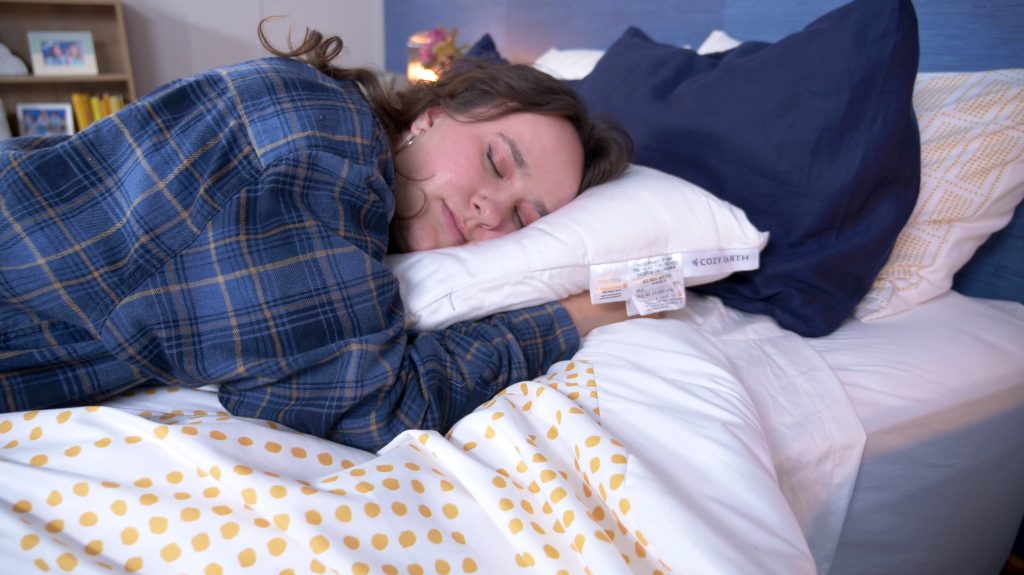
A Look Into the Sleepopolis Testing Lab
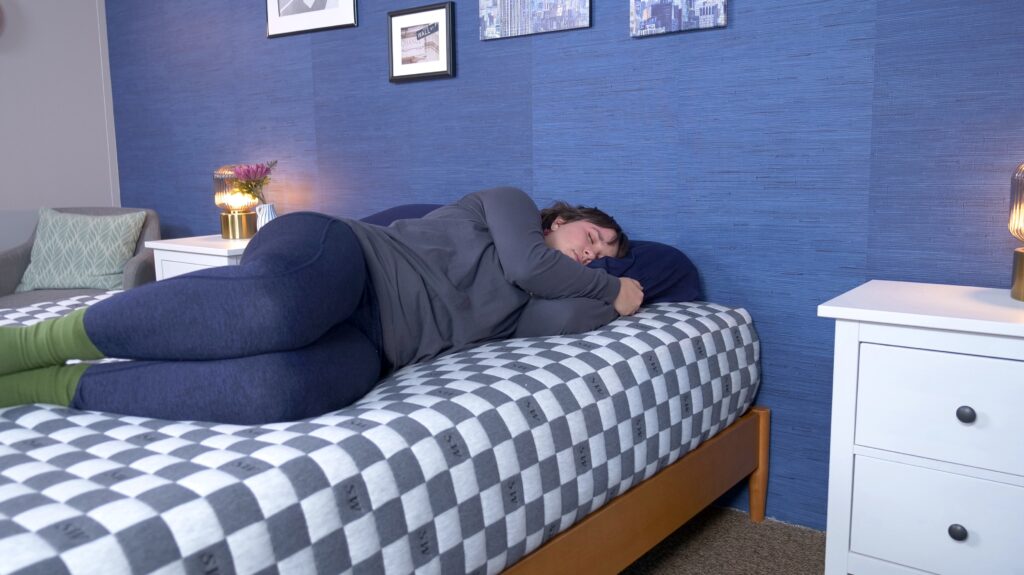
In order to ensure that we’re recommending the best mattresses to sleepers everywhere, we test each one individually in our mattress lab in Raleigh, North Carolina. Here, our team of Certified Sleep Science Coaches has reviewed more than 300 beds, putting each one through a rigorous testing process that includes measuring a mattress’s motion transfer with a seismometer, tracking its cooling capabilities with a thermal gun, and visualizing its ability to relieve pain with a pressure map.
From there, we give every bed an overall score based on its materials, comfort, support, cooling, edge support, and more. We also factor in brand performance with categories such as value and warranty.
We know that sleep is an integral part of your health, which is why we’ve developed such a detailed methodology when testing mattresses and writing our reviews. We also know that every sleeper is different when it comes to body type, sleeping position, and mattress preference. With so many factors at play, we want to give you an informed opinion so you can make an informed purchase.
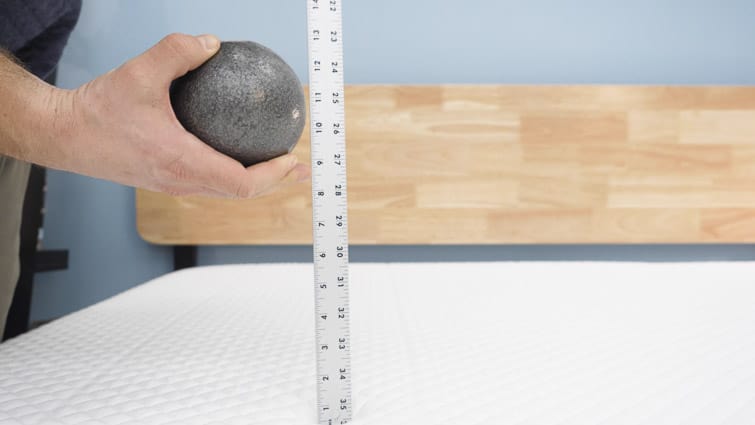
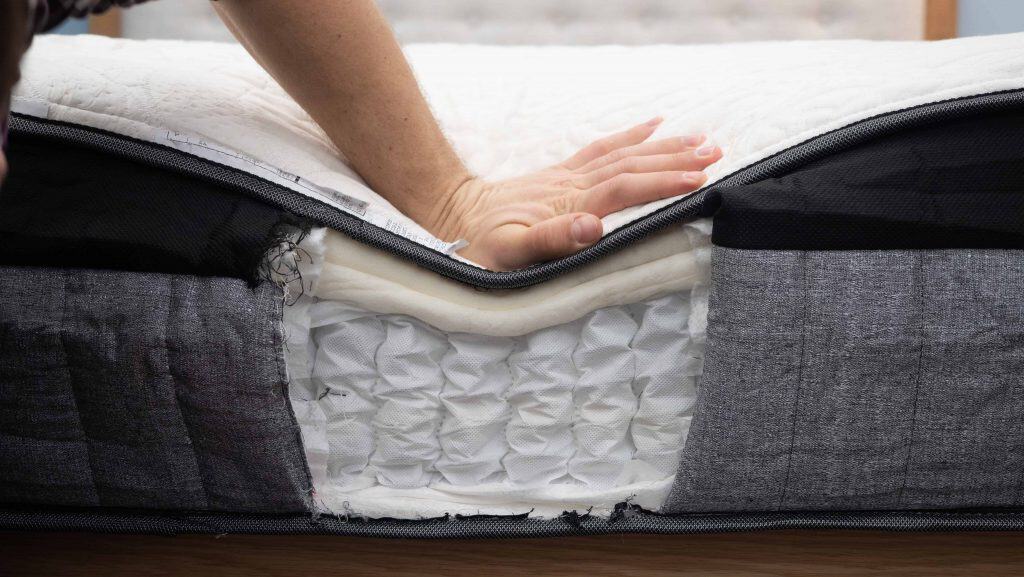
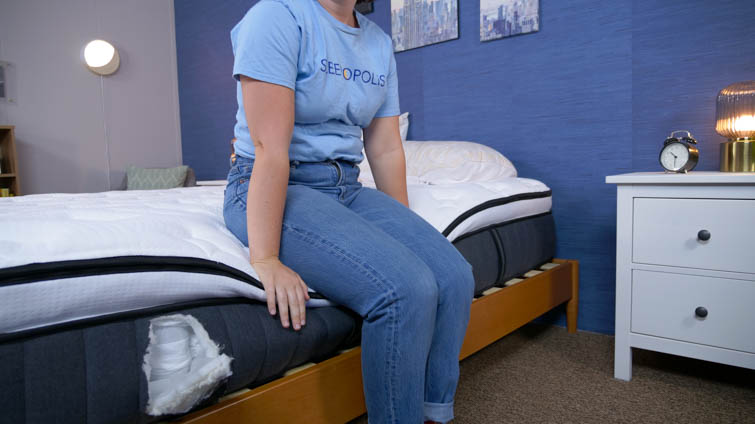
How We Chose These Mattresses
When choosing the best mattresses for stomach sleepers, we primarily focused on firmness and support. Because stomach sleepers tend to put more pressure on their bed than other sleeping positions, they usually need a firmer and more supportive mattress. That’s why we mostly included beds that come in multiple firmness levels or scored at least a 7 out of 10 on our mattress firmness scale. Anything 7 or above can be classified as firm, and should help prevent stomach sleepers’ hips from bowing into the mattress’s layers and throwing their spine out of alignment.
FAQs
How can I avoid sleeping on my stomach?
If stomach-sleeping is causing neck or back strain, you may want to break the habit. Try sewing a tennis ball into the front of your shirt or positioning your pillow around your body to keep you on your back or side. Try a supportive pillow that cradles your neck and head and makes it more difficult to sleep on your stomach.
What is considered the best position for sleeping?
Sleeping positions are a matter of personal preference, but back- or side-sleeping is typically the most comfortable and offers great spinal alignment.
Is it healthier to sleep on a firm mattress?
A mattress is a good fit for you if it’s comfortable, doesn’t cause or worsen aches and pains, and promotes a good night’s sleep. When sleeping on a firm mattress, the bones can absorb most of the pressure and put less stress on joints and muscles. A firm mattress may be better for back and stomach sleepers, while a slightly softer mattress might be the best choice if you sleep on your side.
Is it okay to sleep without a pillow?
Sleeping without a pillow or with a flatter pillow may actually be best if you sleep on your stomach. The less you lift your head while sleeping on your stomach, the less your arch your neck, which helps to lower the risk of back and neck strain.
What is the best mattress for stomach sleepers?
While every stomach sleeper is different in terms of body type and personal preferences, we love the DreamCloud Premier. Its durable coils keep sleepers’ spines in alignment, but it still has a cushy Euro top for added comfort.
What mattress firmness level is best for stomach sleepers?
Generally, stomach sleepers are going to want a firm mattress. That way, the hips remain lifted and the back won’t sink out of alignment.
Best Mattresses for Stomach Sleepers 2024
| Mattress | Best For | Price (Queen) | Coupon | Review |
|---|---|---|---|---|
| Helix Dawn | Overall | $1,373 | Apply Helix Coupon | Read Our Review |
| Nectar Hybrid | Kids | $1,199 | Apply Nectar Coupon | Read Our Review |
| WinkBeds Original | Hybrid | $1,799 | Apply WinkBed Coupon | Read Our Review |
| Saatva | Back Pain | $1,995 | Apply Saatva Coupon | Read Our Review |
| Plank Firm | Firm | $1,332 | Apply Brooklyn Bedding Coupon | Read Our Review |
| Emma Hybrid Comfort | Couples | $1,199 | Apply Emma Coupon | Read Our Review |
| Bear Elite Hybrid | Soft | $2,305 | Apply Bear Coupon | Read Our Review |
| Nolah Evolution | Cooling | $2,499 | Apply Nolah Coupon | Read Our Review |
| Brooklyn Bedding Signature Hybrid | Lightweight Sleepers | $1,332 | Apply Brooklyn Bedding Coupon | Read Our Review |
Sources
Slide show: Sleeping positions that reduce back pain. Mayo Clinic. May 5, 2022. https://www.mayoclinic.org/diseases-conditions/back-pain/multimedia/sleeping-positions/sls-20076452?s=3
Caggiari, Gianfilippo. What type of mattress should be chosen to avoid back pain and improve sleep quality? Review of the literature. Journal of Orthopaedics and Traumatology. December 2021. https://www.proquest.com/openview/3598c678646b0e82f1820fc1e0d5ffa3/1?pq-origsite=gscholar&cbl=2034708
Poorbaugh, Keith. Personal interview.
Skarpsno Schjelderup Eivind. Sleep positions and nocturnal body movements based on free-living accelerometer recordings: association with demographics, lifestyle, and insomnia symptoms. Nature and Science of Sleep. July 7, 2017. https://www.dovepress.com/sleep-positions-and-nocturnal-body-movements-based-on-free-living-acce-peer-reviewed-fulltext-article-NSS

